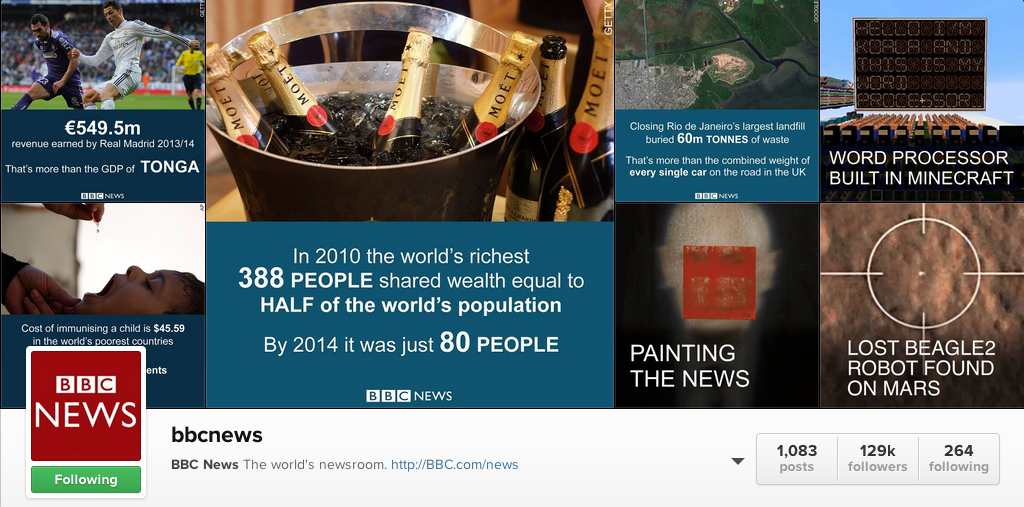 I’ve written in the past about BBC’s Ebola crisis communication strategy to help educate West Africans and keep them healthy and Ebola-free.
I’ve written in the past about BBC’s Ebola crisis communication strategy to help educate West Africans and keep them healthy and Ebola-free.
But it’s not just in communicating and educating about Ebola that BBC is excelling. Their entire communications strategy is one that can and should be used as an example.
Crisis communication is all about providing accurate and timely information directly to your stakeholders, on the platforms that they want to receive it. It’s about understanding technology and the 24-hour news cycle and using these tools and crisis realities to work for your organization in a crisis, rather than against it. (Tweet this!)
So how can the BBC be used as a good example of this? Looking at their Instafax strategy is a good place to start.
Instafax: News bulletins for short attention spans
Instagram reportedly has over 300 million active users, with an average of 70 million photos uploaded to the social media platform each and every day [Source: Instagram.com]. With that many active users all around the world, it might make sense that BBC, one of the largest broadcasters in the world, would consider using Instagram as a way to provide updates on current events to a portion of their market. And so, in 2014, BBC launched Instafax and, after a year of experimentation, the strategy is still going strong (and I’m subscribed!).
Instafax is BBC’s new media way of sharing highlights from world events, by creating and publishing 15-second news bulletins to Instagram. Here’s an example:
Why is Instafax so noteworthy?
It’s important to find new ways to leverage the technology and tools available to keep your audience engaged and connected to your channels. It’s important to practice your communications and experiment with new strategies prior to experiencing a crisis.
Instafax does this. BBC has discovered an engaging way to provide their audience (and probably a new and fresh audience group, as Instagram has many young users) with news bulletins in short format – which is important since attention spans continue to shrink.
Let me ask you some questions: When it’s most important to reach your stakeholders, can you do so successfully and in real-time? Do you know where they are online and how they prefer to receive important and timely updates? Do you know how to grab their attention and hold it?
In a crisis is not when you want to be answering these questions. Issues and crises escalate quickly these days, and positioning your organization as the credible source of information in a crisis is challenging. That’s why it’s important to think through these questions and experiment with different ways of reaching your stakeholders, in real-time, as a crisis preparedness strategy.
Begin thinking it through now
The following are some questions to help you get started. These questions require thought and actual research on your end, if you’re going to answer them correctly.
- Who are your stakeholders (both internal and external) that you need to communicate with in different types of crises? Think through your different categories of crises and actually make a list of the different stakeholders that you would need to communicate with in each crisis scenario.
- How does each stakeholder group prefer to receive important communications from your organization? Do research, conduct surveys, ask your clients directly. Figuring out their preference is important.
- What social media and other channels are they actively on, every day? Does their preferred means of communication with your organization align with the answers to this question? If so, make sure you understand the platforms and have a presence on them.
- What are some examples of organizations or campaigns that have excelled on these platforms? What made them excel? Don’t reinvent the wheel, study their strategy, fails and successes, and determine how these strategies (or a version of) might work for you.
- How can these successful strategies be incorporated into your crisis communication strategy? Figure this out and then test it. Don’t just assume that it will be a successful way to communicate. Run some campaigns and test it out prior to a crisis. This will provide you with a deeper understanding of the platform, how your stakeholders interact on it and with you, and help you strengthen your strategy for effective crisis communication.
Successful crisis management is all about transparent, two-way and real-time communication. Take a cue from BBC and put some thought into developing a communication strategy that will position your organization as a crisis communication pro. (Tweet this!)

Author of Crisis Ready: Building an Invincible Brand in an Uncertain World, Melissa Agnes is a leading authority on crisis preparedness, reputation management, and brand protection. Agnes is a coveted keynote speaker, commentator, and advisor to some of today’s leading organizations faced with the greatest risks. Learn more about Melissa and her work here.
